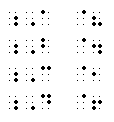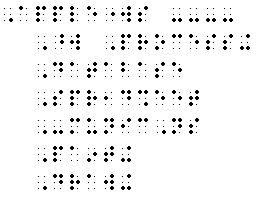|
Complete documentation for punctuation, enclosures, and groups is provided in Rule 6 of the Formats code.
Punctuation
A reading of the rules on punctuation suggests a commonsensical approach -- that is, it is often the case that the braille version ignores the print format and describes to the braille reader the deviation in a Transcribers Note. For example, if the punctuation is shown in bold red letters, the Transcribers Note might say:
"On this page, the print shows all exclamation points in red letters."
Likewise, there may be other specialized notations, such as underlined punctuation marks. If all of the punctuation is underlined, an inserted Transcriber's Note is warranted. The rule on emphasized punctuation also indicates that the transcriber can use a braille italic indicator.
In this section, probably the most confusing part of Rule 6 concerns the print slash (/). The slash should be brailled as   , and needs to be included on your special symbols page. Be careful with slashes in technical works (computers, chemistry) and other foreign language materials, they must be brailled according to the appropriate rules regarding slashes. , and needs to be included on your special symbols page. Be careful with slashes in technical works (computers, chemistry) and other foreign language materials, they must be brailled according to the appropriate rules regarding slashes.
Freestanding punctuation is preceded by a dot 4. In the example below, the punctuation marks are shown as part of a multiple-choice exercise:
| Print version |
Braille version |
- ?
- .
- ,
- !
|
 |
In cases where the use of standard punctuation marks might be confusing, the transcriber is encouraged to spell out the names of the punctuation rather than use punctuation symbols (Rule 6, §1c).
Foreign punctuation has its own peculiarities, and the reader is invited to review the rule concerning foreign punctuation.
Enclosures
Enclosures are those print features that serve to set off specific pieces of text. These are not to be confused with boxes, which have their own set of rules. An enclosure might look something like this:
| Print version |
Braille version |
 |
 |
We used a braille double dash here to represent the print version of the enclosure, as directed by Rule 6, §2c(2). The rule suggests that a transcriber's note be added to ensure clarity for the reader.
For linear enclosures, the rule provides a list of symbols that are to be used. The transcriber is again cautioned that these enclosure symbols are not for use in mathematics, technical materials, music, or computer, as described in Rule 1, §1a(1).
|